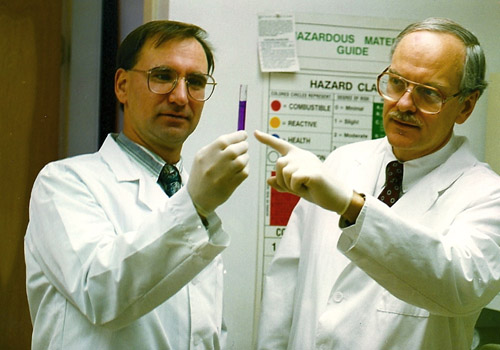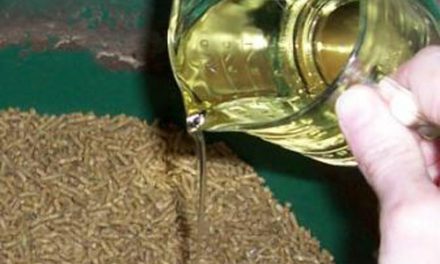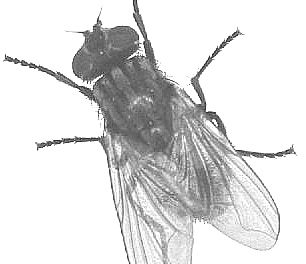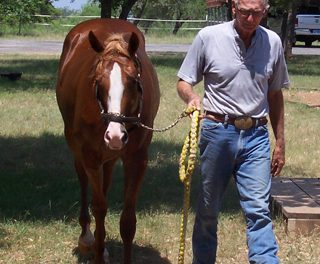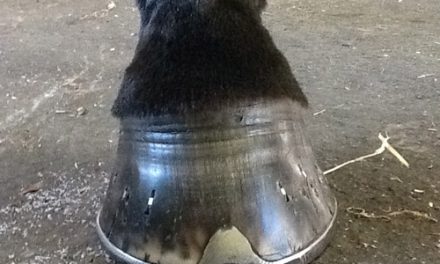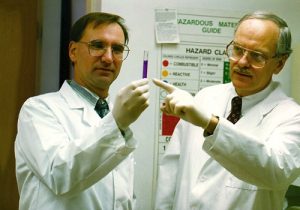 Most people do not know for sure if their horses have gastric ulcers. They may only suspect the presence of ulcers because of small noticeable changes in their horse’s condition. For example, adult horses with ulcers can exhibit a combination of poor appetite, dullness, attitude changes, decreased performance, poor body and hoof condition, rough hair coat, weight loss and colic. Treating gastric ulcers with acid blockers sometimes helps to relieve the symptoms, but may prolong the problem.
Most people do not know for sure if their horses have gastric ulcers. They may only suspect the presence of ulcers because of small noticeable changes in their horse’s condition. For example, adult horses with ulcers can exhibit a combination of poor appetite, dullness, attitude changes, decreased performance, poor body and hoof condition, rough hair coat, weight loss and colic. Treating gastric ulcers with acid blockers sometimes helps to relieve the symptoms, but may prolong the problem.
During a recent swing last season through the major horse racing training facilities in Florida, researchers from SBS EQUINE conducted over twenty interviews with some of the top trainers in the country. Although most of them share health information regularly with their neighboring trainers, the feeding program for the horses under their control was, in some cases, considered a trade secret. After all, it is a competitive industry and feed is what fuels the animal. However, although most of the trainers surveyed admitted to having problems with gastric equine ulcers, those who said that they had few or no problems at all, did seem to follow a similar feeding pattern.
Horses have evolved through 35 million years of evolution to eat many small meals per day, almost on a continual basis. Even though the horse’s stomach is only 8 percent of digestive tract (eight quarts or two gallons), the emptying time of the stomach can be a mere twelve minutes and the rate of passage through the small intestine one foot per minute. The small volume of the stomach and the rapid passage of food to the small intestine is the reason that horses can and are designed to eat almost continuously. Gastric pH can drop lower than 2 soon after a horse stops consuming food and the stomach will continue to produce strong acid even if food is not present.
SBS researchers discovered in the Florida training facilities, those trainers that fed their horses four or five small meals a day had far fewer problems with gastric ulcers than those who were fed two or three meals a day. The bottom line is that concentrated feeding can inadvertently contribute to ulcer formation by its influence on increasing serum gastric levels, lowering the horse’s roughage intake and reducing the amount of time spent eating. Imposed feed deprivation, such as in colic management cases, can result in erosion and ulceration of the gastric mucosa as well.
In the case of competitive horses, they are often not fed immediately prior to training or competing. This could result in a significant increase in stomach acidity. Also, horses can become excited during training and racing, further lowering gastric pH. These influences contribute to gastric ulceration. Studies show that the greater the degree of training activity, the increasing severity of gastric lesions. Further, lesions were induced and maintained in thoroughbred horses during simulated training, using a diet of coastal Bermuda and concentrate. Although Dr. N. J. Vatistas stopped short of recommending all racehorses in training receive gastric ulcer treatment, he did indicate that “The truth may not be far from that”.
Ulcer Formation Mechanism
Gastric ulceration in horses results from an imbalance between offensive factors, e.g. acid and pepsin, and defensive factors such as mucus, bicarbonate, prostaglandins, mucosal blood flow and epithelial restitution. Most of these ulcers occur in the fundic portion of the stomach, which has a phospholipid rich, protective epithelial layer. Disruption of this barrier (mucous, surface-active phospholipids) is initial to the destruction of the stomach’s surface epithelium. Because most domesticated horses do not feed constantly like nature designed them to, excess acid can ulcerate this protective layer. Unless the mucous lining is strong enough to withstand the powerful acids produced here, ulcers often develop.
Management of Equine Gastric Ulcers
Various therapeutic protocols have been suggested for the control of equine gastric ulcers. These include antacids, (think of products such Tums and Rolaids) and H2 acid blockers such as the pharmaceutical products Pepsid and Prilosec. These treatments will reduce acid in the fundic portion of the stomach and will reduce the occurrence of ulcers, but there may be unintended negative consequences from these treatments. Stomach acid is an extremely important component of the initial stage of the digestive process. If in this initial stage of digestion there is not adequate acid present to break down food, it will pass into the small intestine only partially digested. The nutrients won’t be in a form that can be absorbed in the small intestine and the horse will not be adequately nourished.
There is a better way to protect the horse from and treat gastric ulcers. When the horse is given a combination of lecithin and apple pectin as a nutritional supplement to his normal diet, the acid in the fundic portion of the stomach immediately breaks it down into a mix of reactive phospholipids. The phospholipids in lecithin are both hydrophilic and hydrophobic and interact with the cell membranes of the mucosal epithelium to strengthen the mucosa. Research has shown that lecithin not only treats the symptoms of equine ulcers, it helps cure the ulcers as well by making the stomach lining stronger at the cellular membrane level. The beneficial effects of a diet supplemented with lecithin and pectin also enhances the rest of the digestive tract as well. There has been much research to substantiate this. They also observed horses fed lecithin had reduced levels of excitability and anxiety that was attributed to the healing of gastric ulcers.
Summary
A well studied health condition in horses is gastric ulcers. The presence of these ulcers is associated with poor condition, irritability and poor performance. Treatment options such as reducing stomach acid production is expensive (up to $35/day) and can disrupt the normal digestive process by not allowing the food to begin its initial breakdown as nature intended. A less expensive and more effective treatment is to give horses a nutritional supplement of lecithin containing apple pectins ( about $3.00/day). The lecithin strengthens the epithelial lining of the stomach treating and preventing gastric ulcers and allow for the proper absorption of nutrients in the small intestine. The apple pectins help to buffer the stomach lining and slow the digestive process. Pectins also are probiotic in that they support beneficial microflora in the gastrointestinal tract.
Lecithin and apple pectin have proven a valuable natural supplement for horses to treat and prevent gastric ulcers. Lecithin/apple pectin can be added quickly and easily to a horse’s daily feed ration or to almost any homemade horse treat recipe. Horse treats containing lecithin/apple pectin given between feedings and after training can help protect the stomach from the damaging affects of excess acid which is a natural occurrence in horses.
When sourcing lecithin and apple pectin, remember that not all lecithin granules are the same. The best source of lecithin is a brand that contains apple pectins and sold through a dealer that sells animal products. For more articles on gastric equine ulcers and other horse related issues, check out www.sbsequine.com.
Special thanks to the contributions of Dr. Craig Russett, Ph.D in Animal Nutrition.
References
Geor.R.j. and Papich (1990). Medical therapy for gastrointestinal ulceration in foals. Comp. Cont. Edu. Pract. Vet. 12:403-412.
Ghyczy,M., E. Hoff; J. Garzib (1996). Gastric mucosa protection by phosphatidylcholine (PC) Presented at: The 7th International Congress on Phospholipids, Brussels, Belgium.
Jones, W.E. (1999). Equine gastric ulcer syndrome. J. Equine Vet. Sci. 19:296-306.
Murray, M.J.; C.M. Murray, H.J. Sweeney, J. Weld, N.J. Digby Wingfield and S.J Stoneham (1996). The prevalence of gastric ulcers in foals in Ireland and England: An edoscopic survey. Equine Vet. J. 28(5):368-374.
Russett, J.C. (1997). Lecithin applications in animal feeds. Specialty Products Research Notes. LEC-D-56.
Traub, J.L.; A.M. Gallina, B.D. Grant, S.M. Reed, P.R. Gavin and L.M. Paulsen (1983). Phenylututazone toxicosis in the foal. Am. J. Vet. Res. 44:1410-1418.
Vatitstas, N.J.; Snyder, G. Carlson, B. Johnson, R.M. Arthur, Thurmond, and K.C.K. Lloyd (1994). Epidemiological study of gastric ulceration in the Thoroughbred racehorse: 202 horses 1992-1993. 40th AAEP Convention Proceedings. pp 125-126.
Wright, B. (1999). Equine digestive tract structure and function. Ontario Ministry of Agriculture.

